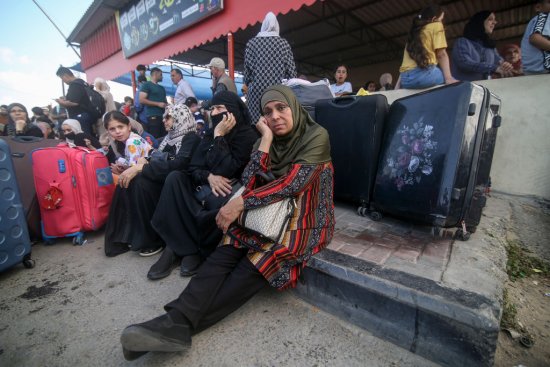
The sole passageway between Gaza and Egypt remains sealed to both refugees and humanitarian aid.
The sole passageway between Gaza and Egypt remains sealed to both refugees and humanitarian aid.
On Monday, hundreds of people began gathering at the Rafah border crossing, the sole passageway between the Gaza Strip and neighboring Egypt, in hopes of fleeing Gaza before Israel launches an expected ground offensive. But they remain stranded at the border a day later, after Israeli airstrikes forced the crossing to shut down completely.
It remains unclear which regional actor is behind the closed borders, according to reports by the Associated Press.
[time-brightcove not-tgx=”true”]Several Israeli airstrikes have reportedly hit the area in the past few days, killing at least 49 people at the crossing and in the nearby town of Khan Younis on Tuesday, according to Gaza’s interior ministry. So far, the Israel-Hamas war has left at least 2,800 people in Gaza dead and 10,000 injured. In Israel, 1,400 people have died and 3,900 have been wounded.
Read more: For Gazans, There Are No Safe Havens
The blocked border artery is delaying the delivery of medical supplies and humanitarian aid into the besieged territory of Gaza, after some 160 trucks left from al-Arish in Egypt’s Sinai peninsula carrying hundreds of tons of Egyptian and international aid. Aid convoys remain parked on the Egyptian side as of publication.
U.S. President Joe Biden is expected to travel to Israel on Wednesday to meet with Israeli leaders, after which he will make a trip to Jordan to meet with Arab leaders amid fears that the fighting could destabilize broader regional relations.
Where is the Rafah border crossing and why is it closed?
Situated on Gaza’s southern border with Egypt, the Rafah crossing is one of two land routes out of the Gaza Strip, and the only exit into non-Israeli territory. Alongside Israel, Egypt has enforced a 16-year land, air, and sea blockade, which has restricted the passage of imports to the region and prevented most Palestinians from crossing the border. In the past, Egyptian authorities have attributed the strict restrictions on movement through this border to security concerns in north Sinai.
But reports from the U.N. suggest that Egypt’s reluctance to open the Rafah crossing in recent days comes in the hopes of avoiding a mass exodus of hundreds of thousands of Palestinians, which could result in their permanent resettlement in Egypt.
Egypt has maintained a decades-long position that allowing a mass exodus of Gazans would “revive the idea that Sinai is the alternative country for the Palestinians,” Mustapha Kamel al-Sayyid, a political scientist at Cairo University, told the New York Times.
As the first Arab state to sign a peace treaty with Israel in 1979 after fighting several wars, Egypt has long played a mediator role in the Arab-Israeli conflict, as well as during the in-fighting of Palestinian factions including Hamas and Fatah.
On Monday, Egypt’s Minister of Foreign Affairs Sameh Shoukry said that, “Until now the Israeli government has not taken a position on opening the Rafah crossing from the Gaza side to allow the entrance of assistance and exit of citizens of third countries.”

How does the sealed border impact humanitarian aid efforts?
On Oct. 14, a plane carrying health supplies from the World Health Organization’s logistics hub in Dubai landed at Al-Arish airport to meet critical health needs in Gaza, according to a statement from WHO. They include trauma medicines and health supplies to treat 1,200 wounded patients and 1,500 patients suffering from heart disease, hypertension, diabetes, and respiratory problems, as well as basic essentials for nearly 300,000 people, including pregnant women.
WHO Director-General Tedros Adhanom Ghebreyesus met with Egyptian President Abdel Fattah El-Sisi on Oct. 9 to request that the delivery of supplies from WHO to Gaza be facilitated via the Rafah crossing. Despite these talks, however, the supplies remain on the Egyptian side of the border.
Read more: How Israel-Hamas War Misinformation Is Spreading Online
“Every hour these supplies remain on the Egyptian side of the border, more girls and boys, women, and men, especially those vulnerable or disabled, will die while supplies that can save them are less than 12 miles away,” WHO said in a press statement, calling for an immediate opening of the crossing.
On Tuesday, U.S. Secretary of State Antony Blinken said that an agreement had been reached with Israel “to develop a plan” to get aid into Gaza following nine hours of negotiations, though he did not provide details on what the aid plan would look like. “Today, and at our request, the United States and Israel have agreed to develop a plan that will enable humanitarian aid from donor nations and multilateral organizations to reach civilians in Gaza,” Blinken said.
What happens to U.S. citizens stranded in Gaza?
Those waiting at the border include approximately 600 Americans, according to estimates from the U.S. State Department, as well as Palestinians with other dual citizenship. The U.S. has promised them a safe passageway into Egypt, but diplomatic efforts to ensure this have continued to stall.
Over the weekend, U.S. national security adviser Jake Sullivan acknowledged that no American citizens have been able to cross the border, adding that in the meantime, the U.S. was working with the U.N., Israel, Egypt, and Jordan to try to ensure “safe places that civilians can go that will not be subject to bombardments.”